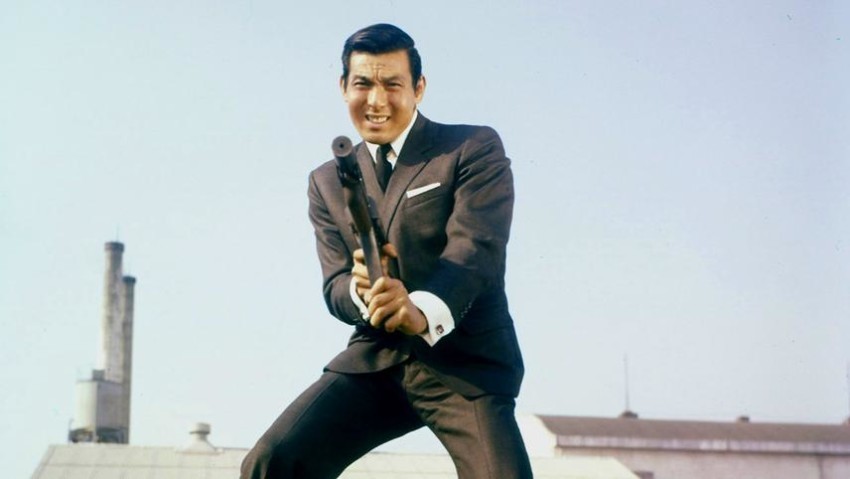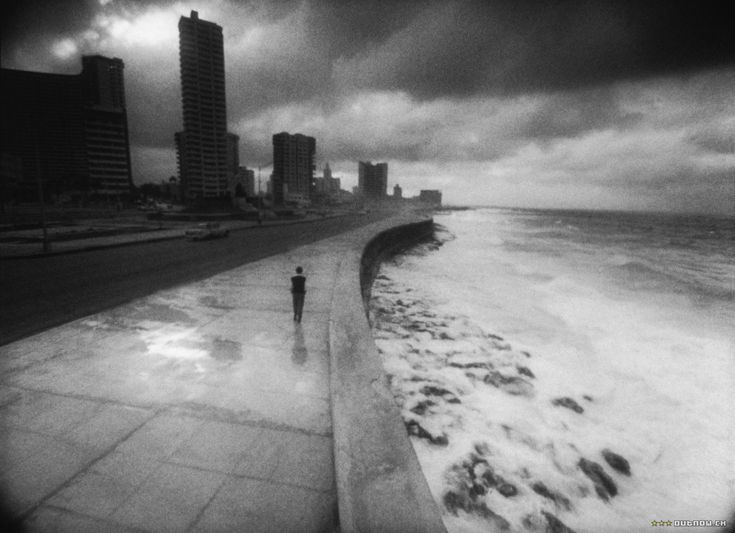Seijun Suzuki’s 1963 colorful genre defying action movie starring Jo Shishido as a private eye working with local police to infiltrate an arms dealing Yakuza clan.
The Production: 4/5
Detective Bureau 2 – 3: Go to Hell Bastards was one of four movies directed by Seijun Suzuki in 1963; his 27th feature for Nikkatsu Studios since 1956, the year of his debut feature, Victory is Ours. Detective Bureau 2 – 3: Go to Hell Bastards stars Jo Shishido as private eye Hideo Tajima who working with local police infiltrates an organized mob involved with gun running and possibly drug dealing. Tajima is a flashy sports-car-driving, hard-bitten shamus in the Sam Spade mode who is always stylishly dressed as opposed to the drab outfits worn by city police detectives; Tajima is a cross between Mike Hammer and James Bond. Tajima’s motives are unclear, similar to Mifune’s Sanjuro or Eastwood’s Man with No Name. He claims that his motives are always mercenary, and he works antagonistically and sometimes unethically with police detectives envious of Tajima’s style and money. His manner can be brutal, at two points in the movie, he slaps and punches the leading lady. The punch in the stomach is especially shocking. In spite of this, Tajima does have a moral code that he scrupulously follows.
Suzuki is an eccentric director. He is a master stylist capable of taking routine or even silly material and whipping it up into something memorable in spite of itself. Whether working in black and white or color, his films are always visually expressive with wonderful set design and are meticulously framed. Action is excitingly staged and dynamically cut, such as the opening gun battle, the murder of Manabe and his girlfriend, and the fiery climax. His use of the scope frame is inventive. In this film, he plays with the delivery of exposition through either radio and television reports or even in song. The first film I saw of his, twenty years ago, was Tokyo Drifter, a film so different from any American movie of its type that I described it to a friend as a cross between Sam Fuller and Vincente Minnelli.
Go to Hell Bastards was written by Iwao Yamazaki, who appears to have been a prolific genre screenwriter. It’s based on a novel by pulp writer Haruhiko Oyabu. I’m not sure how closely the script follows the novel, but it is typical of other Japanese genre productions from the era in that it is a mash up of genres that sometimes defies logic yet is always entertaining. 1950’s and 60’s Japanese genre jumping is similar to Italian films of the era and is totally unheard of in post code American cinema, with the exceptions of ultra-low budget productions.
Go to Hell Bastards is a cross between a Yakuza and secret agent movie with dashes of the musical and western thrown in for good measure. A lot of this genre shifting is communicated by Harumi Ibe’s playful musical score, utilizing jazz and conventional action movie music. In fact, there are three musical numbers in Go to Hell Bastards, each in a different style ranging from flapper-era Tin Pan Alley to Rock and Roll. The musical numbers are cleverly used to either describe characters and their relationships or convey exposition.
The script bounces around so much that it is sometimes hard to guess where it is going. The film opens with an explosive gun fight between two gangs. Manabe, a survivor of the battle is picked up and jailed by the police. Manabe is a marked man because neither gang trusts him. This sets up a situation similar to Rio Bravo, where criminals are gathering in front of the police station waiting to pounce on Manabe. Instead of building around this tense situation, the movie goes off in another direction in a matter of minutes.
Under the Japanese studio system, directors had little say about what projects they could accept, and after nearly thirty of these types of films it appears that Suzuki played around with conventions to avoid boredom. The tone is playful bordering on self-parody. When Tajima rescues Manabe from the certain death awaiting him at the police station, Tajima takes Manabe to his girlfriend’s apartment. It’s not stated, but Manabe’s girlfriend is obviously a prostitute whose apartment is bathed in pastel and deep red lighting. Manabe’s relationship with his girlfriend is rooted in S & M – he physically torments her, and she emotionally torments him, a form of foreplay that leads to passionate sex; and it’s played for laughs! This is something you would never see in an American movie of the era.
The downside of this bouncing around is that some things don’t get properly developed such as the opening gun battle. It opens with American soldiers supplying arms to the gangsters. The second gang appears in a Pepsi Cola truck lobbing bombs and bullets. After this sequence the American involvement is never mentioned again. Certainly, military guns being sold would have to be done at levels higher than that of a GI, though we never learn. Was this just a sly jab at America, implying that along with soda pop (pop culture) the U.S. exports gun violence? Unfortunately, this theme is not more fully developed.
Video: 4.5/5
3D Rating: NA
Detective Bureau 2 – 3: Go to Hell Bastards is presented in its original anamorphic 2.35:1 ratio. It’s a very clean and sharp transfer with deep blacks, one of the best I’ve seen of these Nikkatsu titles. The transfer notes say only that it is a high definition transfer from Nikkatsu. Colors generally pop, such as in the above-mentioned girlfriend’s apartment and the musical number scenes. There are a few shots that look a little faded, but nothing too noticeable. There is some grain present.
Audio: 4/5
There is only one audio option, Japanese LPCM 1.0 mono. The soundtrack sounded fine on my system.
There are English subtitles.
Special Features: 2.5/5
There are only two supplements on the disc:
The first is a 30-minute interview with British film historian Tony Rayns. He talks mainly about Suzuki, Shishido, and the Japanese Yakuza genre. He claims that the movie was intended as the beginning of a series but was unsuccessful and puts the blame on the two actors who are the comic relief. I think that might be an over simplification as comic relief is always a matter of taste, and we have no way of knowing how this pair played to original audiences; I’ve seen far worse. Rayns is also incorrect when he says there was no sequel; there was one sequel released six months later, but it was not directed by Suzuki.
There is a slide show of images also included.
Liner notes by Jasper Sharp are included. He too writes more generally about Suzuki and the genre and like the interview, not enough about this particular production.
Overall: 4/5
Detective Bureau 2 – 3: Go to Hell Bastards is a lot of fun. It doesn’t take itself seriously and moves at pace that keeps you paying attention and not questioning the logic. I’ve become a big fan of these Nikkatsu movies of the 1950’s – 60’s. They’ve become staples (like Rathbone Sherlock Holmes, Mr. Moto, Charlie Chan, Universal horror, Hammer, Toho) of my cinematic comfort food diet. Any lover of action films can’t go wrong with Detective Bureau 2 – 3: Go to Hell Bastards. Arrow does their usual excellent job with this title.
https://www.amazon.com/Detective-Bureau-Bastards-Special-Blu-ray/dp/B07CQR5SRQ/ref=sr_1_1_twi_blu_2?ie=UTF8&qid=1532996243&sr=8-1&keywords=detective+bureau+2-3+go+to+hell+bastardsPost Disclaimer
Some of our content may contain marketing links, which means we will receive a commission for purchases made via those links. In our editorial content, these affiliate links appear automatically, and our editorial teams are not influenced by our affiliate partnerships. We work with several providers (currently Skimlinks and Amazon) to manage our affiliate relationships. You can find out more about their services by visiting their sites.






Similar threads
- Todd Erwin
- Blu-ray and UHD
2